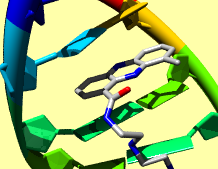Raytracing with POV-Ray
The Persistence of Vision Raytracer (POV-Ray)
is included with Chimera. POV-Ray images can be saved:
Only the PNG (*.png) image format can be saved.
In addition to images, files for POV-Ray containing the scene (*.pov)
and the raytracing options (*.ini) may be generated.
Various raytracing parameters can be set in the
POV-Ray Options
preferences.
See also:
exporting a scene,
tips on preparing images
Limitations
Using transparency or
per-model
clipping may increase rendering time significantly.
A raytraced image from POV-Ray may differ from the view in Chimera
in several ways. Some differences are desirable, such as the presence
of shadows. Others reflect current limitations of the POV-Ray format
and/or its implementation in Chimera:
- colors may differ slightly
- shading along ribbons may be stairstepped; the supersmooth
ribbon
style is recommended to decrease this effect
- parts of objects cut away with the
global clipping planes in Chimera
will still be shown in the raytraced image (however, the effects of any
per-model
clipping will be included)
- light source directions but not
colors are translated from Chimera
- shininess and
brightness levels but not specular color are translated from Chimera;
however, objects tend to appear shinier in the raytraced image
- pseudobonds are always shown as
sticks, even when shown as dashed lines in Chimera
- if depth cueing is used,
the background of the raytraced image will match the depth-cueing color
even if the background was a different color in Chimera
- the following are omitted or otherwise not handled:
silhouette edges,
selection highlighting,
stereo,
lenses,
Volume Viewer transparent solid displays,
and normals on dot and mesh surfaces
- max_trace_level is set to 10 to improve multi-level transparency,
but this also increases time and memory requirements relative to lower levels
[details at the POV-Ray site]
UCSF Computer Graphics Laboratory / October 2007

